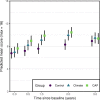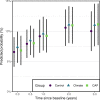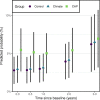Universal cannabis outcomes from the Climate and Preventure (CAP) study: a cluster randomised controlled trial
- PMID: 30253790
- PMCID: PMC6157057
- DOI: 10.1186/s13011-018-0171-4
Universal cannabis outcomes from the Climate and Preventure (CAP) study: a cluster randomised controlled trial
Abstract
Background: The Climate and Preventure (CAP) study was the first trial to assess and demonstrate the effectiveness of a combined universal and selective approach for preventing alcohol use and related harms among adolescents. The current paper reports universal effects from the CAP study on cannabis-related outcomes over three years.
Methods: A cluster randomized controlled trial was conducted with 2190 students from twenty-six Australian high schools (mean age: 13.3 yrs., SD 0.48). Participants were randomised to one of four conditions; universal prevention for all students (Climate); selective prevention for high-risk students (Preventure); combined universal and selective prevention (Climate and Preventure; CAP); or health education as usual (Control). Participants were assessed at baseline, post intervention (6-9 months post baseline), and at 12-, 24- and 36-months, on measures of cannabis use, knowledge and related harms. This paper compares cannabis-related knowledge, harms and cannabis use in the Control, Climate and CAP groups as specified in the protocol, using multilevel mixed linear models to assess outcomes.
Results: Compared to Control, the Climate and CAP groups showed significantly greater increases in cannabis-related knowledge initially (p < 0.001), and had higher knowledge at the 6, 12 and 24-month follow-ups. There was no significant difference between the Climate and CAP groups. While no differences were detected between Control and the CAP and Climate groups on cannabis use or cannabis-related harms, the prevalence of these outcomes was lower than anticipated, possibly limiting power to detect intervention effects. Additional Bayesian analyses exploring confidence in accepting the null hypothesis showed there was insufficient evidence to conclude that the interventions had no effect, or to conclude that they had a meaningfully large effect.
Conclusions: Both the universal Climate and the combined CAP programs were effective in increasing cannabis-related knowledge for up to 2 years. The evidence was inconclusive regarding whether the interventions reduced cannabis use and cannabis-related harms. A longer-term follow-up will ascertain whether the interventions become effective in reducing these outcomes as adolescents transition into early adulthood.
Trial registration: This trial was registered with the Australian New Zealand Clinical Trials Registry (ACTRN12612000026820) on the 6th of January 2012, https://www.anzctr.org.au/Trial/Registration/TrialReview.aspx?id=347906&isReview=true.
Keywords: Cannabis; Combined; Online; Prevention; School; Selective; Universal.
Conflict of interest statement
Ethics approval and consent to participate
This study was approved by the University of New South Wales Human Research Ethics Committee (approval code HC11274), the Sydney Catholic Education Office (approval code 772), and the New South Wales Department of Education and Training (approval code 2011201). Both participants and their parents provided consent to take part in the study.
Consent for publication
Not applicable, the study report details related to any individual person’s data.
Competing interests
MT & NN are two of the developers of the Climate Schools programs and PC is the developer of the Preventure program. MT & NN are Directors of Climate Schools Pty Ltd.
Publisher’s Note
Springer Nature remains neutral with regard to jurisdictional claims in published maps and institutional affiliations.
Figures




Similar articles
-
Pathways to prevention: protocol for the CAP (Climate and Preventure) study to evaluate the long-term effectiveness of school-based universal, selective and combined alcohol misuse prevention into early adulthood.BMC Public Health. 2018 May 21;18(1):643. doi: 10.1186/s12889-018-5554-y. BMC Public Health. 2018. PMID: 29783974 Free PMC article. Clinical Trial.
-
The long-term effectiveness of universal, selective and combined prevention for alcohol use during adolescence: 36-month outcomes from a cluster randomized controlled trial.Addiction. 2021 Mar;116(3):514-524. doi: 10.1111/add.15178. Epub 2020 Aug 4. Addiction. 2021. PMID: 32621555 Clinical Trial.
-
The CAP study, evaluation of integrated universal and selective prevention strategies for youth alcohol misuse: study protocol of a cluster randomized controlled trial.BMC Psychiatry. 2012 Aug 20;12:118. doi: 10.1186/1471-244X-12-118. BMC Psychiatry. 2012. PMID: 22906138 Free PMC article. Clinical Trial.
-
Effective school-based preventive interventions for alcohol use in Africa: a systematic review.Afr Health Sci. 2020 Sep;20(3):1397-1406. doi: 10.4314/ahs.v20i3.45. Afr Health Sci. 2020. PMID: 33402988 Free PMC article.
-
A Review of Personality-Targeted Interventions for Prevention of Substance Misuse and Related Harm in Community Samples of Adolescents.Front Psychiatry. 2019 Jan 22;9:770. doi: 10.3389/fpsyt.2018.00770. eCollection 2018. Front Psychiatry. 2019. PMID: 30723431 Free PMC article. Review.
Cited by
-
Trauma-informed prevention programmes for depression, anxiety, and substance use among young people: protocol for a mixed-methods systematic review.Syst Rev. 2023 Oct 31;12(1):203. doi: 10.1186/s13643-023-02365-4. Syst Rev. 2023. PMID: 37907971 Free PMC article.
-
A Web-Based Alcohol and Other Drug Prevention Program (Strong & Deadly Futures) for Aboriginal and Torres Strait Islander School Students: Protocol for a Cluster Randomized Controlled Trial.JMIR Res Protoc. 2022 Jan 7;11(1):e34530. doi: 10.2196/34530. JMIR Res Protoc. 2022. PMID: 34994696 Free PMC article.
-
Bridging the gap between genetic epidemiological research and prevention: A randomized control trial of a novel personalized feedback program for alcohol and cannabis use.Drug Alcohol Depend. 2023 Aug 1;249:110818. doi: 10.1016/j.drugalcdep.2023.110818. Epub 2023 Jun 7. Drug Alcohol Depend. 2023. PMID: 37327509 Free PMC article. Clinical Trial.
-
The effectiveness of an indicated prevention programme for substance use in individuals with mild intellectual disabilities and borderline intellectual functioning: results of a quasi-experimental study.Addiction. 2021 Feb;116(2):373-381. doi: 10.1111/add.15156. Epub 2020 Sep 21. Addiction. 2021. PMID: 32678489 Free PMC article. Clinical Trial.
-
Digital interventions for substance use disorders in young people: rapid review.Subst Abuse Treat Prev Policy. 2023 Feb 17;18(1):13. doi: 10.1186/s13011-023-00518-1. Subst Abuse Treat Prev Policy. 2023. PMID: 36805783 Free PMC article. Review.
References
-
- European Monitoring Centre for Drugs and Drug Addiction: Prevention of Addictive Behaviours. Luxembourg: Publications Office of the European Union; 2015.
-
- AIHW . Drug statistics series no 28 Cat no PHE 183. AIHW: Canberra; 2014. 2013 National Drug Strategy Household Survey report.
-
- Hasin Deborah S, Wall Melanie, Keyes Katherine M, Cerdá Magdalena, Schulenberg John, O'Malley Patrick M, Galea Sandro, Pacula Rosalie, Feng Tianshu. Medical marijuana laws and adolescent marijuana use in the USA from 1991 to 2014: results from annual, repeated cross-sectional surveys. The Lancet Psychiatry. 2015;2(7):601–608. doi: 10.1016/S2215-0366(15)00217-5. - DOI - PMC - PubMed
-
- Hibell B, Guttormsson U, Ahlström S, Balakireva O, Bjarnason T, Kokkevi A, Kraus L. The 2007 ESPAD report: substance use among students in 35 European countries. Stockholm. Sweden: The European School Survey Project on Alcohol and Other Drugs; 2007.
-
- Whiteford HA, Degenhardt L, Rehm J, Baxter AJ, Ferrari AJ, Erskine HE, Charlson FJ, Norman RE, Flaxman AD, Johns N, et al. Global burden of disease attributable to mental and substance use disorders: findings from the global burden of disease study 2010. Lancet. 2013;382:1575–1586. doi: 10.1016/S0140-6736(13)61611-6. - DOI - PubMed
Publication types
MeSH terms
Grants and funding
LinkOut - more resources
Full Text Sources
Other Literature Sources
Medical
Miscellaneous

